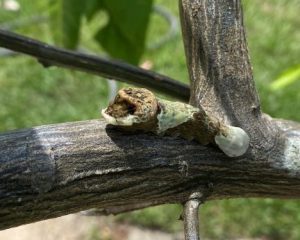
Caterpillars are top candidates for the hide and seek champions of the world. Fat, juicy morsels for birds, lizards, and small mammals, they are vulnerable prey for hundreds of would-be predators. Possessing no wings (until they metamorphosize into moths and butterflies) and with limited speed, they have evolved incredible methods of hiding in plain sight. One of my favorites, and most frequently asked about, is the giant swallowtail caterpillar, (aka “orange dog” due to its preference for citrus), which looks exactly like a large swath of bird poop. All species have an innate aversion to their own waste, so what more genius way to hide from a bird that disguising yourself as its feces? Brilliant. Gross, but brilliant.

Recently, one of our Master Naturalist graduates found a caterpillar in his flower beds and sent in photos out of curiosity. Without the contrast on the handle of a garden shovel, you could hardly see this well-blended critter. It looks almost exactly like tree bark, with the mottled gray-brown patches of local oak trees. Unfortunately, after extensive research and consultation with several entomologists, the jury is still out on its exact identification. We narrowed it down to a member of the Family Noctiudae, which includes nearly 3,000 species in North America—and 20,000 worldwide! These are generally larger gray and brown caterpillars that grow into nocturnally active moths and feed on plants, lichens, and fungi.
The best educated guesses for this particular caterpillar include an ilia underwing moth (Catocala ilia) or an owlet, which is a member of the genus Zale. The best way to definitively identify a caterpillar is to raise it to adulthood, then identify it by the moth or butterfly it becomes. As adults, both of these caterpillars blend very well into tree bark, and the ilia underwing actually feeds on oaks. The Zale caterpillar feeds on needles and leaves, and as close relatives they are difficult to discern. Interestingly, several resources refer to the Zale as “muscular,” noting that when disturbed it can actually leap off a branch to flee a potential threat.
 2
2
